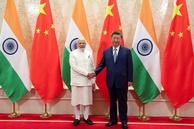For centuries, the Indian Ocean and South Asia have played a significant role in the struggle for leadership between the great powers. The 21st century is no exception. The region is becoming the focus of strategic competition between leading regional and non-regional actors again. It requires a response from India, especially in building relations not only with China, the United States, or Japan but also with its closest neighbors. Under the prevailing circumstances, one of the most promising areas of New Delhi's foreign policy is the India — Bangladesh — Sri Lanka strategic triangle, which has significant political, defense, and economic potential, and, most importantly, can provide a stronger basis for multilateral cooperation in the region.
Increase of geostrategic competition in the Indian Ocean and South Asia
For centuries, the Indian Ocean and South Asia have faced strong external influence and competition from non-regional actors. Due to its unique geographic location, this region has crucial strategic importance both in terms of trade and defense. The reality is that no country in the world can become a superpower unless it provides dominance over the dual area of the Indian and the Pacific Oceans. For example, China has been trying for decades to gain a presence in the Indian Ocean in an attempt to reduce its dependence on the Strait of Malacca, including due to the implementation of infrastructure projects in Myanmar, Pakistan, Sri Lanka, the Maldives, etc. In response to the growing influence of the PRC, the United States has replaced its Pacific and African Commands to the Indo-Pacific and supports the ambitions of Japan, Australia, and European states to increase their influence in the region.
In turn, India had accurately predicted this tendency. Moreover, back in 2004, New Delhi’s maritime doctrine stated that “All the major powers of this century will seek a toehold in the Indian Ocean Region”.[1]
However, central to India’s foreign policy vision is the growing influence of Beijing in New Delhi's traditional «zone of influence». Over the past decade, China has become one of the major trade and investment partners for the countries of South Asia and the Indian Ocean: Chinese companies are actively implementing infrastructure projects aimed at building highways, railways, and ports, and almost all countries in the region have joined the Belt and Road initiative (exceptionally Bhutan and India itself). Despite the economic nature of China's cooperation with the countries of the region, Beijing's geostrategic benefits from the rapprochement with New Delhi's closest neighbors attract the attention of India's expert, academic communities, and, probably, authorities.
At the same time, in the face of turbulence in the Sino-Indian relations, as well as their tension in Eastern Ladakh, it was widely analyzed the trend of Indian rapprochement with the United States, Japan, and Australia, which allowed New Delhi to increase its credibility, both among its closest neighbors and in the wider Indo-Pacific. However, India continues to adhere to its foreign policy course, taking a more concrete, but still restrained position on the issue of cooperation with Western actors. At the same time, India uses its increased role in the region to build a strategic triangle with Bangladesh and Sri Lanka — two intraregional states with high importance in the region's geopolitics and solid experience of interaction with middle and great powers. If Sri Lanka is an important trading hub of the Indian Ocean and is also suitable for hosting navy vessels, then Bangladesh is a «gateway» for India to Southeast Asia, which will be increasingly opened as relations between Dhaka and New Delhi strengthen, as well as the development of the north-eastern states of India.[2]
The emerging triangle between India, Bangladesh, and Sri Lanka
Anyway, due to the economic, political, and military rise, China has been able to create a geostrategic space for itself in South Asia and the Indian Ocean. In recent years, China has become one of the leading trading partners and a foreign direct investment (FDI) source for most of the countries of the region, which was undoubtedly beneficial for Beijing. So, in 2017, Sri Lanka joined the «Belt and Road Initiative», opening the doors for China's companies to implement major infrastructure projects on its territory. In the same year, the parties reached an agreement on the construction of a port and airport on southern Sri-Lanka's coast in Hambantota as part of China's loans. The project cost was US$361 million. However, with the increase in the number of Chinese infrastructure projects, as well as the number of loans from the PRC, Sri Lanka faced the inability to independently compensate its debt. As a result, China has leased for 99 years the port of Hambantota on the terms of a debt swap, and the total debt of Colombo to Beijing in 2020 was amounted to about US$5 billion.[3] Thus, China's economic influence allowed it to gain more strategic space in India's traditional region of influence as well as to gain a solid foothold in Sri Lanka.
The current environment caused the retaliatory measures from India, which has intensified the Sri Lankan vector of its foreign policy. Of course, compared to investments from China, Indian financing of projects in Sri Lanka is more modest, but, at the same time, targeted and focused on the sustainable development of Sri Lanka's territories. New Delhi has already provided about US$1.3 billion for the development of the railway network between the southern and northern regions of Sri Lanka[4], over US$45.27 million — for the modernization of Kankesanturai Port[5] and Palaly Airport[6], as well as cooperates with Tokyo on the development of the East Container Terminal (ECT) in the capital port of Sri Lanka.[7] Moreover, in 2018, during a meeting of the Standing Parliamentary Committee on Foreign Relations of India, the Secretary of the Ministry of Foreign Affairs, former Indian Ambassador to China Vijay Gokhale and experienced diplomat stated, and I quote: «So, our efforts are to assist them [ed. the states of the region — A.G.] in building infrastructure projects which will hopefully also be able to reduce the dependency on China in terms of infrastructure requirement». [8]
Against the backdrop of high debt liability and the economic impact of the COVID-19 pandemic, Sri Lanka received support from India, Bangladesh, and China. Earlier in the year, India offered Sri Lanka to supplement its foreign exchange reserves by US$1 billion, while Bangladesh, whose per capita income is twice as low as Sri Lanka's, also didn't stand aside and reached an agreement to provide the Sri Lankan side with US$200 million.[9]
In such a case, it would be important to highlight at least three details. First, the currency swap agreement between Bangladesh and Sri Lanka marked the first time that a country in the region other than India has provided significant financial support to another country in South Asia.[10] Second, the joint actions of India and Bangladesh have balanced a similar agreement between China and Sri Lanka on a currency swap worth US$1.54 billion. Finally, New Delhi's assistance, combined with Dhaka's rational approach to its economy (Bangladesh's external debt amounted to 16-18% of GDP in 2016-2019, and foreign exchange reserves — $45 billion), can facilitate the exchange of experience among the region's countries in order to avoid situations of excessive dependence and increased debt to more influential partners. A special role, in this case, can be played by platforms for multilateral intraregional dialogue, including the Bay of Bengal Initiative for Multisectoral Technical and Economic Cooperation (BIMSTEC), the Indian Ocean Rim Association (IORA) and the South Asian Association for Regional Cooperation (SAARC), which includes all parties to the emerging triangle.
At the same time, India and Bangladesh are working towards strengthening not only economic but also defense ties with Sri Lanka. In 2019, New Delhi and Colombo reached an agreement to strengthen defense cooperation, including training of the island state's military personnel. Moreover, the triangle countries have aт extensive experience in conducting bilateral and multilateral exercises, as evidenced by the recent India — Sri Lanka naval exercises (October 2020) and the joint maneuvers between India, Bangladesh, Sri Lanka, and Bhutan (April 2021).[11] Given the increased Sino-US rivalry in the region, as well as a large number of non-traditional security threats (drug smuggling, piracy, pollution from navigation and excessive fishing), the multidimensional cooperation of New Delhi, Dhaka and Colombo may be useful.
Analyzing the specific case of Bangladesh, it should be noted its economic success, including high GDP rates of economic growth, as well as the intensification of maritime and land trade. Thus, in 2011, New Delhi and Dhaka resolved a long-standing territorial dispute and demarcate the land border that certainly strengthened the level of mutual trust between the countries. Moreover, Bangladesh has joined the 1360-kilometer India — Myanmar — Thailand (IMT) highway project, becoming part of an ambitious opportunity to link the South and Southeast Asia's countries.
The growing involvement of Bangladesh in issues of intraregional security, maintaining a stable situation in South Asia and the Indian Ocean, as well as its growing synergy with India, provoked rumors about the possible joining of Dhaka to the Quadrilateral Security Dialogue (Quad). China reacts sharply to the activities of the Quad, openly calling it an anti-Chinese coalition. In the case of Bangladesh, the China's reaction was also not long in coming. In May 2021 PRC's Ambassador Li Ziming warned Dhaka that its joining the Quad would cause significant damage to its bilateral relations with Beijing. Responding to this statement, the Foreign Minister of Bangladesh, Dr. Abdul Momen, assured the Chinese side that Dhaka adheres to a balanced foreign policy and non-alignment course. Moreover, the Quad countries haven't yet approached Bangladesh on this issue[12] but, according to the Bangladeshi official, Dhaka will determine the course of its foreign policy in the interest of its people itself.[13]
Considering the gradual building of the Quad into a military coalition, as well as the growing number of pro-American articles in some of the media in the region, Beijing's reaction is quite understandable. Moreover, the verbal duel didn't lead to dramatic deterioration of bilateral relations between China and Bangladesh (the next month after the Quad incident, «Xinhua» reported that Dhaka and Beijing had agreed to expand their already close military cooperation) [14]. However, Dhaka's reaction has become a marker of its growing regional influence, as well as the PRC's close attention to India's active engagement as one of the Quad sides with other countries of South Asia and the Indian Ocean, including Bangladesh and Sri Lanka.
Conclusion
Due to increased competition of non-regional actors in the Indian Ocean and South Asia, India and the regional countries face a number of challenges. On the one hand, the variability of the Indo-Pacific vision shared by the Quad countries gave New Delhi more weight, but led to increased rivalry in its «area of responsibility» and damaged the relations with China. On the other hand, New Delhi is skillfully taking advantage of the opportunity, using its increased influence to strengthen relations not so much with the United States, Australia and Japan, but with its neighbors in the region. The clearest expression of this is the emerging strategic triangle between India, Bangladesh and Sri Lanka, which has significant political, defense and economic prospects.
In view of the fact that the PRC considers India as its main competitor in the Indian Ocean, and their further rivalry with high probability will take place in the struggle for the loyalty of small intraregional states, the idea of a strategic triangle with Bangladesh and Sri Lanka can be a successful preventive game on the part of New Delhi. Still, it is too early to talk about the full commitment of the two countries to India's foreign policy vision. Of course, Bangladesh and Sri Lanka are interested in a stable and secure environment in the region, but in the short and medium-term outlook, they will continue to avoid the excesses in relations with larger powers, using the competition of India, China and a number of non-regional actors to attract the essential funding.
[1] Holslag, J. China and India: Prospects for Peace. Contemporary Asia in the World // Columbia University Press, 2009. P. 133
[2] Jaishankar, S. The India Way: Strategies for an Uncertain World. HarperCollins Publishers, 2020. PP. 86–87
[3] China extends $500 million loan to Lanka // The Hindu. URL: https://www.thehindu.com/news/international/china-extends-500-million-loan-to-lanka/article34305277.ece
[4] India smoothens journey from Colombo to Jaffna via rail // The Economic Times. URL: https://economictimes.indiatimes.com/news/politics-and-nation/india-smoothens-journey-from-colombo-to-jaffna-via-rail/articleshow/70281115.cms?from=mdr
[5] Sri Lanka to make Kankesanturai commercial port with India funds // Economy Next. URL: https://economynext.com/sri-lanka-to-make-kankesanturai-commercial-port-with-india-funds-9191/
[6] Flights soon from Sri Lanka’s Jaffna to 4 Indian cities but not Chennai. Here’s why // Hindustan Times. URL: https://www.hindustantimes.com/india-news/flights-soon-from-srilanka-s-jaffna-to-4-indian-cities-but-not-chennai-here-s-why/story-Ad5cSDmUzDvnIHVTRvtwrL.html
[7] India, Japan cooperating in Bangladesh, Sri Lanka to strengthen Quad — envoy Suzuki // The Print. URL: https://theprint.in/diplomacy/india-japan-cooperating-in-bangladesh-sri-lanka-to-strengthen-quad-envoy-suzuki/601791/
[8] India Sounds Alarm on Chinese Infra Projects in Neighbourhood // The Wire. URL: https://thewire.in/diplomacy/china-making-headway-in-infra-projects-in-indias-neighbourhood-foreign-secretary-gokhale-to-panel
[9] $200 million currency swap: Stepping up in Sri Lanka’s hour of need // The Daily Star. URL: https://www.thedailystar.net/frontpage/news/bangladesh-steps-sri-lankas-hour-need-2098805
[10] As Bangladesh Rises, Sri Lanka Finds India is Not the Only Neighbour with Deep Pockets // The Wire. URL: https://thewire.in/south-asia/bangladesh-sri-lanka-south-asia-india-deep-pockets
[11] India, Bhutan, Sri Lanka & Bangladesh to hold joint military exercise // The Times of India. URL: https://timesofindia.indiatimes.com/india/india-bhutan-sri-lanka-bangladesh-to-hold-joint-military-exercise/articleshow/81847315.cms
[12] 'We decide our foreign policy': Bangladesh's curt response to China over warning to join Quad // Hindustan Times. URL: https://www.hindustantimes.com/world-news/we-decide-our-foreign-policy-bangladesh-s-curt-response-to-china-over-warning-to-join-quad-101620729070540.html?utm_source=twitter&utm_medium=social&utm_campaign=ht_AMP
[13] Bangladesh rebuffs China on Quad warning // The Hindu. URL: https://www.thehindu.com/news/international/bangladesh-rebuffs-china-on-quad-warning/article34542373.ece
[14] China wants Bangladesh by its side against the US-India coalition // Prothom Alo. URL: https://en.prothomalo.com/bangladesh/china-wants-bangladesh-by-its-side-against-the-us-india-coalition
read more in our Telegram-channel https://t.me/The_International_Affairs

 10:10 25.06.2021 •
10:10 25.06.2021 •



























